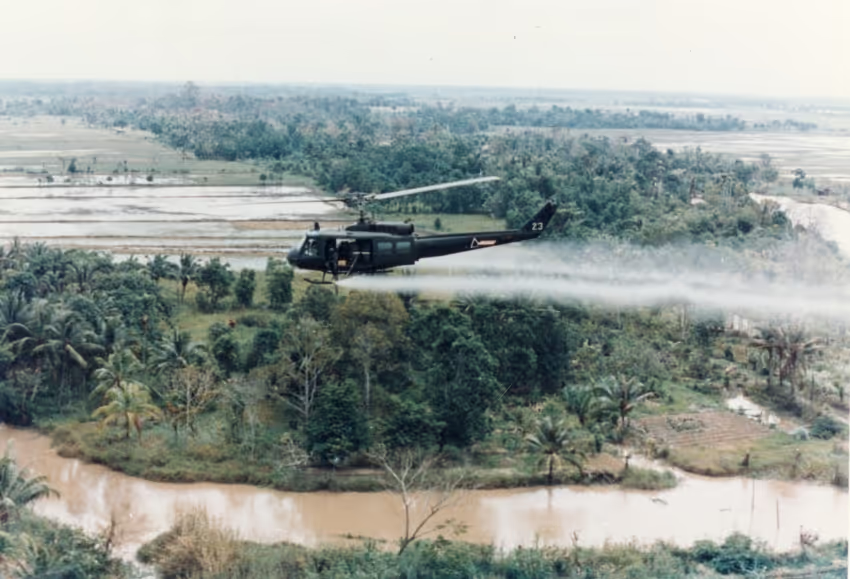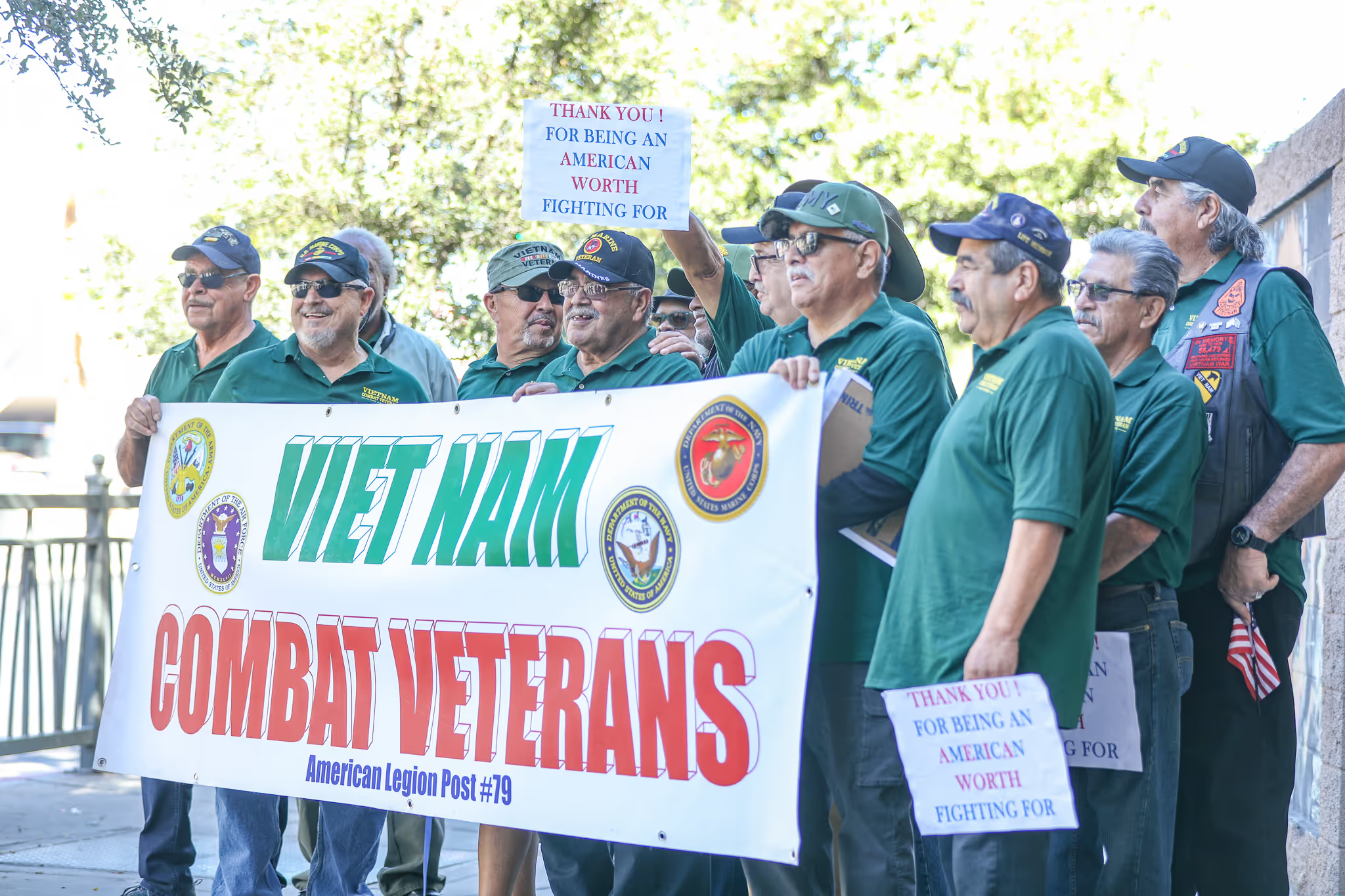Like many other occupations, serving in the military may have involved exposure to paints or other chemical exposures as part of an assigned job on a base. For example, if a veteran worked in a machine shop or as a mechanic they were potentially exposed to harmful chemicals. Therefore, it is also valuable to ask a veteran what their job was while in the military.
However, for those who were deployed, there are specific environmental exposures that have been identified as serious health risks. Harmful chemical or airborne exposures are specific to certain locations or war zones and that is another reason you should know in what era a veteran served and if they were deployed to a war zone. Below are specific eras/war zones and their associated exposures and health conditions:
VIETNAM: AGENT ORANGE
During the war in Vietnam, the US military sprayed the herbicide Agent Orange from 1961-1971 as part of a program code-named “Operation Ranch Hand” to clear the leaves and vegetation that provided cover for opposing forces. Exposure to Agent Orange and its primary toxic substance, tetrachlorodibenzo-p-dioxin (TCDD), has been associated with a host of illnesses in Vietnam veterans and Vietnamese people. The conditions that the VA now officially recognizes as associated with Agent Orange exposure include:
- Chronic B-cell Leukemias
- Type 2 Diabetes
- Hodgkin’s Disease
- Ischemic Heart Disease
- Respiratory cancers
- Prostate cancer
- Parkinson’s
- Non-Hodgkin’s lymphoma
It is important to understand that Vietnam veterans did not have to been on the ground in Vietnam or neighboring areas to be exposed, as the conditions also present in veterans who served in planes or on ships in Vietnam. In addition, recent research suggests that Agent Orange exposure increases the risk of developing dementia twofold. If you have a Vietnam veteran in your care who presents with these conditions, it is important that they know about service-connected disability benefits.
In part 1, we interview Paul Cox, Vietnam Veteran, who discusses Agent Orange and the advocacy of Vietnam veterans, and we draw similarities to the current efforts of Iraq and Afghanistan veterans to gain recognition for health issues related to burn pits and other toxic exposures. (20:58)
GULF WAR (IN KUWAIT AND IRAQ): GULF WAR ILLNESS
Soon after the Gulf War, known as Operation Desert Storm, veterans who served in the region began complaining of physical health symptoms that were initially not recognized as being associated with any known illness or deployment to the gulf region. While researchers continue to investigate the specific environmental risks for many of the conditions that are part of Gulf War illness, ongoing studies suggest the exposures include:
- Chemical and biological weapons, such as sarin and cyclosarin that were found stored at a munitions storage depot in Iraq.
- Airborne hazards such as sand and dust, particulate matter, exhaust fumes, and smoke from oil well fires.
- Pesticides that were used to protect against insects or pathogens.
- Exposure to excessive heat.
- Chemical substances that were used to protect military vehicles from corrosion.
Although there is still a lot to be explored and confirmed about the various symptoms and exposures, the VA has classified as presumptive a cluster of illnesses in veterans that must have manifest when they were on active duty in Gulf War region military operations and are at least 10 percent disabling. The presumed conditions include:
- Myalgic Encephalomyelitis/Chronic Fatigue Syndrome (ME/CFS), which is characterized by severe fatigue that is not relieved by rest and not due to any other illness or condition.
- Fibromyalgia, for which the primary symptom is broad muscle pain and can also include insomnia, memory difficulties, headaches and stiffness in the morning.
- Gastrointestinal disorders that are chronic or recurrent.
- Symptoms of undiagnosed illnesses including: Abnormal weight loss, fatigue, cardiovascular disease, neurological and psychological problems, muscle and joint pain, headaches, menstrual disorders, skin conditions, respiratory problems, and sleep disturbances.
- Poor motor functioning.
Some providers treating Gulf War veterans have regarded the symptoms as unexplained—a cluster not seen in any known condition—and may overlook their illness or assume their complaints are mostly psychosomatic.
In part 2, we interview Paul Sullivan, Gulf War Veteran, who discusses the emergence of Gulf War Illness from toxic exposures and the advocacy of Gulf War veterans for research, diagnosis, and treatment. (60 min)
POST-9/11: IRAQ AND AFGHANISTAN (BEGINNING OCTOBER 7, 2001): BURN PITS
As with veterans who served during the Gulf War era, Iraq and Afghanistan veterans were at risk for exposure to extreme temperatures (heat in Iraq; both heat and cold in Afghanistan), many of the same chemical substances and biological weapons, and airborne hazards such as sand and dust, particulate matter, exhaust fumes, and smoke from oil well fires. However, new wars brought new toxic exposures:
Burn pits were open-air sites for burning of trash and other waste, emitting smoke and fumes that released a number of harmful substances including Dioxin, particulate matter, carbon monoxide, hexachlorobenzene, and ash. Eighty-six percent of participants in a 2019 Iraq and Afghanistan Veterans of America (IAVA) survey reported exposure to burn pits or other toxins.
Although according to the VA, many of the health outcomes associated with some of the airborne exposures are likely temporary, researchers and clinicians have paid particular attention to the health hazards associated with burn pits.
Veterans and active-duty personnel who deployed to Iraq and Afghanistan have reported a number of respiratory symptoms, including shortness of breath, emphysema, bronchitis, chronic obstructive pulmonary disease, and asthma. Ongoing research focusing on the health risks of burn pit exposure has yielded conflicting results.
Presently, the VA has not classified burn pit exposure as presumptive of health problems and still states that the symptoms and outcomes are temporary. However, there is an airborne hazards and burn-pit registry where veterans can sign up to be included in ongoing research.
INFECTIOUS DISEASE
The VA has identified nine infectious diseases presumed to be associated with exposures to specific infectious pathogens during service in the Gulf War, Iraq and Afghanistan:
- Brucellosis
- Campylobacter Jejuni
- Coxiella Burnetii (Q Fever)
- Mycobacterium Tuberculosis
- Nontyphoid Salmonella
- Shigella
- Visceral Leishmaniasis
- West Nile Virus
In order to qualify as resulting from military service, the VA requires that a condition must have resulted in at least a 10 percent disability within one year after a veteran separated from the military. However, Nontyphoid Salmonella and Visceral Leishmaniasis are not subject to the disability and timing limitations.








